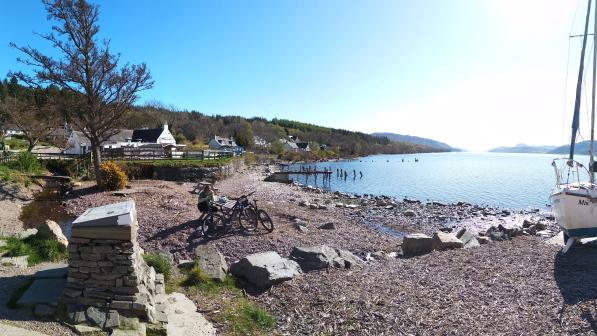Cycling in the Scottish Highlands

The wilderness of the Highlands, particularly the monumental west coast, is like nowhere else in Britain. Its scenery, most dramatic in the rich light of May or September, rivals anywhere in the world. Touring around here is something very special – especially for self-contained cycle-campers, and even more especially for hardcore bikepackers: wild camping is allowed as a matter of course, but midge repellent helps.
The Caledonia Way (part of NCN78) is something extraordinary. Its eastern half runs 66 miles from Fort William, at the foot of Ben Nevis, to Inverness, along the awesome Great Glen Fault. It’s a combination of canal towpaths at the eastern end (many stretches family-friendly), forest roads alongside deserted lochsides, and a quietish road along the southeast shore of Loch Ness. NCN78’s western half goes down from Fort William alongside sea-lochs to Oban. The stretch of child-friendly railpath south of Loch Leven gives marvellous views.
The other major numbered route is NCN1, originally from Dover, going up from Inverness to John o’Groats. The final stretch north along the barely-trafficked A386 (more like a railpath than an A road, through superb scenery) and then east dramatically along the northern coast to the End-to-End’s exordium or terminus is unforgettable.
Away from those, you can pick pretty much any road and have a superb experience. Something unique is to take your bike on the short makeshift passenger boat trip across the Kyle of Durness and the ride along the 11-mile stony access track to Cape Wrath, with its fantastically isolated lighthouse.
And for those who like a challenge, the UK’s most renowned, and most alpine-like, road climb is here. Bealach na Bà (‘Cow Pass’) rises with multiple hairpins from sea level at Loch Kishorn up to the eagles at 626m (2,054 feet) and hurtles down thrillingly to Applecross, where pubs and cafes await.
Cycling groups and clubs in the Scottish Highlands
Cycling UK Highland (Inverness)
http://www.cyclinguk.org/local-groups/highland
https://www.facebook.com/login/?next=https%3A%2F%2Fwww.facebook.com%2Fgroups%2FCyclingUKHighland%2F
Rides in and around Inverness
Wick Wheelers (Wick)
http://www.cyclinguk.org/local-groups/wick-wheelers
East Sutherland Wheelers (Golspie)
http://www.cyclinguk.org/local-groups/east-sutherland-wheelers
The Adventure Syndicate (Inverness)
http://www.cyclinguk.org/local-groups/adventure-syndicate
http://theadventuresyndicate.com/
Collective of female endurance cyclists aiming to inspire others (especially women and girls)
Belles on Bikes Inverness (Inverness)
http://www.cyclinguk.org/local-groups/belles-on-bikes-inverness
Velocity Love Cafe and Bicycle Workshop (Inverness)
https://www.facebook.com/velocitycafe
Social enterprise combining a cafe, a bike workshop and cycling education activities
Glasgow Road Cycling Meetup (Inverness)
http://www.cyclinguk.org/local-groups/glasgow-road-cycling-meetup
Highland Cycle Ability Centre (Cantray)
http://www.cyclinguk.org/local-groups/highland-cycle-ability-centre
http://www.highlandcycleabilitycentre.com/
Aims to give all a safe and enjoyable place to cycle, regardless of ability
What to take with you on your ride
The only thing you really need for cycling is a bike. And maybe a phone, and credit card: in Britain you’re only a call away from any service you might need.
But unless money is no object, it’s wise to take a few things with you on a day ride. A saddlebag or rear rack and panniers are best for carrying stuff. A front basket is second best. A rucksack is third best. Your sweaty back will soon tell you why.
Cycling short distances in jeans and t-shirt is fine, but on a long or strenuous ride – over ten miles say, or in hills – those jeans will rub and the t-shirt will get damp and clingy. Shorts or, yes, lycra leggings and padded shorts will be much comfier, and merino or polyester cycling tops wick away the sweat, keeping you dry and comfy. (They don’t have to be lurid colours.)
If rain’s in the air, pack a rainproof top. If it might turn chilly, take a fleece or warm top. But the thing you’re most likely to forget is the sunblock.
It’s remarkable how often you enjoy being out on the bike so much that you suddenly realise it’s getting dark. So take lights (which are legally required at night). They’re price of a sandwich, take no space, are easy to put on thanks to tool-free plastic clips, and the batteries last for ever.
Take a puncture repair kit (with tyre levers) and pump. Make sure it fits your valves, which will be either ‘Presta’ or ‘Schraeder’ – realising they don’t match is a very common roadside discovery! Carrying a spare inner tube (make sure it matches your tyre size) makes puncture repair much easier: mend the old one back at home. If you do get in trouble, some kindly passing cyclist will probably stop to help.
Using a helmet is a personal choice – they’re not legally required.
Cycling makes you thirsty, so take lots of water. Long-distance riders talk about ‘the bonk’ – a sudden loss of energy rendering you almost stationary. It’s miraculously and instantly cured by eating something sweet. On short rides you’re unlikely to run out of energy, but just in case, take a snack like flapjack, banana, chocolate or jelly babies.
Taking a packed lunch or picnic will save you money, though that hot drink and cake in a cosy cafe could yet prove very tempting!
Your phone GPS could be invaluable for showing where you are when lost; you can download free detailed UK maps and GPS software before your trip.
Paper maps are still useful, though, so take one: no power source or wifi signal required, and they’re great for suggesting possibilities or changes of plan.



